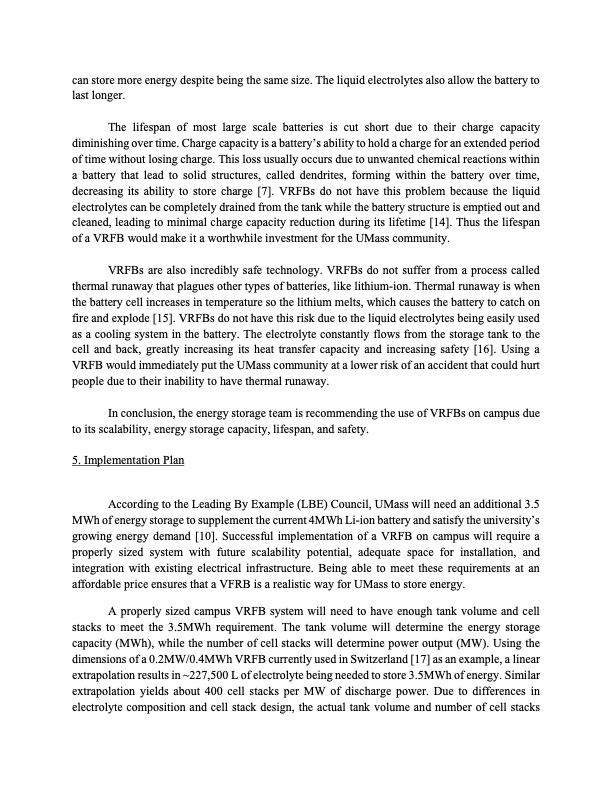
PDF Publication Title:
Text from PDF Page: 005
can store more energy despite being the same size. The liquid electrolytes also allow the battery to last longer. The lifespan of most large scale batteries is cut short due to their charge capacity diminishing over time. Charge capacity is a battery’s ability to hold a charge for an extended period of time without losing charge. This loss usually occurs due to unwanted chemical reactions within a battery that lead to solid structures, called dendrites, forming within the battery over time, decreasing its ability to store charge [7]. VRFBs do not have this problem because the liquid electrolytes can be completely drained from the tank while the battery structure is emptied out and cleaned, leading to minimal charge capacity reduction during its lifetime [14]. Thus the lifespan of a VRFB would make it a worthwhile investment for the UMass community. VRFBs are also incredibly safe technology. VRFBs do not suffer from a process called thermal runaway that plagues other types of batteries, like lithium-ion. Thermal runaway is when the battery cell increases in temperature so the lithium melts, which causes the battery to catch on fire and explode [15]. VRFBs do not have this risk due to the liquid electrolytes being easily used as a cooling system in the battery. The electrolyte constantly flows Using a VRFB would immediately put the UMass community at a lower risk of an accident that could hurt people due to their inability to have thermal runaway. 5. Implementation Plan According to the Leading By Example (LBE) Council, UMass will need an additional 3.5 MWh of energy storage to supplement the current 4MWh Li-ion battery and satisfy the university’s growing energy demand [10]. Successful implementation of a VRFB on campus will require a properly sized system with future scalability potential, adequate space for installation, and integration with existing electrical infrastructure. Being able to meet these requirements at an affordable price ensures that a VFRB is a realistic way for UMass to store energy. A properly sized campus VRFB system will need to have enough tank volume and cell stacks to meet the 3.5MWh requirement. The tank volume will determine the energy storage capacity (MWh), while the number of cell stacks will determine power output (MW). Using the dimensions of a 17 cell and back, greatly increasing its heat transfer capacity and increasing safety [16]. from the storage tank to the In conclusion, the energy storage team is recommending the use of VRFBs on campus due to its scalability, energy storage capacity, lifespan, and safety. 0.2MW/0.4MWh VRFB currently used in Switzerland [ extrapolation results in ~227,500 L of electrolyte being needed to store 3.5MWh of energy. Similar ] as an example, a linear extrapolation yields about 400 cell stacks per MW of discharge power. Due to differences in electrolyte composition and cell stack design, the actual tank volume and number of cell stacksPDF Image | Power of Implementing a Vanadium Redox Flow Battery UMass

PDF Search Title:
Power of Implementing a Vanadium Redox Flow Battery UMassOriginal File Name Searched:
vanadiumredoxflowbatteryicons2paper.pdfDIY PDF Search: Google It | Yahoo | Bing
Salgenx Redox Flow Battery Technology: Salt water flow battery technology with low cost and great energy density that can be used for power storage and thermal storage. Let us de-risk your production using our license. Our aqueous flow battery is less cost than Tesla Megapack and available faster. Redox flow battery. No membrane needed like with Vanadium, or Bromine. Salgenx flow battery
| CONTACT TEL: 608-238-6001 Email: greg@salgenx.com | RSS | AMP |